Nuclear Reactors in Space: TEM
The pinnacle of 20 years of research and development efforts to create space power plants based on nuclear reactors in the USSR was the deuce of the Plasma-A satellites flying in 1988. These installations were based on the technology of thermionic energy conversion, which was debugged on the ground (more than 80 test assemblies were carried out in reactors from 100 to 16,000 hours). The efforts, the scale of the work and the beauty of the idea turned out to be so powerful that in the next 20 years in the articles of specialized organizations that designed and planned spacecraft with nuclear power plants you will find nothing but the development of ideas for reactors with thermionic emission converters. 20 years of talk about a bright nuclear space future ended in October 2009, when not many Plasma-A development projects received funding, and "Transport and energy module" with turbomachine conversion. And at the head of the project were not the people who had been involved in this topic before. One of the key roles in this reversal, in addition to the efforts of lobbyists, was played by one technical idea related to the release of heat in space.
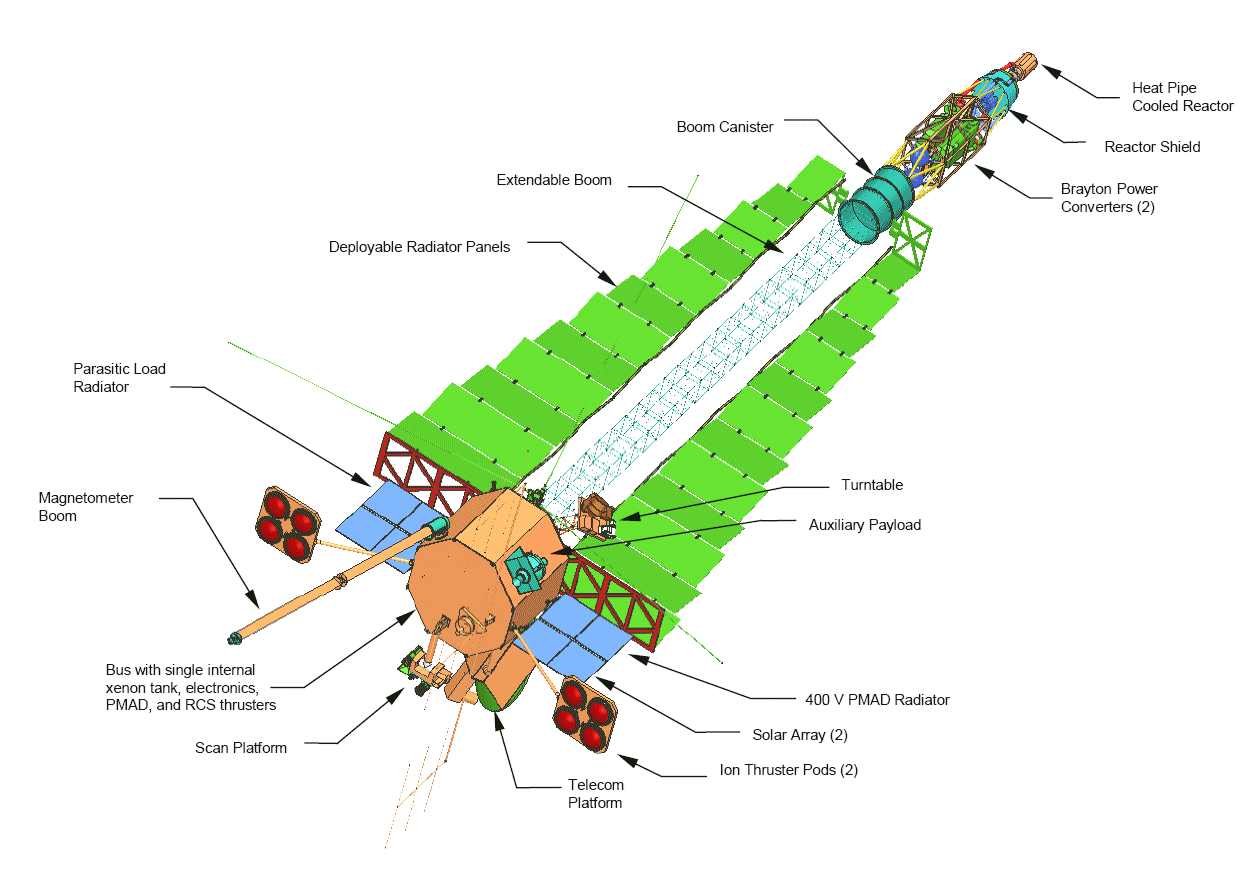
American AMC JIMO, also planned with a nuclear reactor on board.
It is well known that weight is the main enemy of space nuclear power plants, and refrigerators for stray heat are the heaviest element of such devices. In the case of thermionic emission converters, this question is solved quite elegantly - yes, their efficiency is low compared to the turbine cycle, but the temperature of the radiators of the radiators can be very high (about 1000K, and the reactor itself is warmed up to 1650K), and as we remember, the weight of the refrigerators depends from temperature to the power of 1 / T ^ 4. As a result, this power-law dependence is replayed by a fourfold larger volume of heat, which must be discharged from a thermionic nuclear power plant. Only if you do not have the revolutionary idea of a drip CI.
The idea is that instead of driving fluid through the tubes inside the emitting panels, it will fly straight through space - from the nozzle-shapers of the jets to the drop eliminator. In this case, theoretically, the weight of CI can be reduced several times, and losses due to evaporation into vacuum are solved by the selection of a special organosilicon liquid. In this scenario, thermionic nuclear power plants begin to play their “birthmark” - a low power density on the electricity generating fuel rods, and well, the efficiency is 5-8%.
It is this concept of TEM - with turbomachine conversion of thermal energy and drip refrigerators that was proposed by the Keldysh Center Center in 2009. Innovation of the idea fell on fertile ground at the peak of “the development of innovations in the country” by President Medvedev, and multiplied by the strength of the lobbyists of Rosatom and the head of IC Keldysh Academician Koroteyev, it was possible to swap the miserable “archaic” projects of RKK Energia, KB Arsenal, OJSC Krasnaya Zvezda from the board and get the cherished financing.
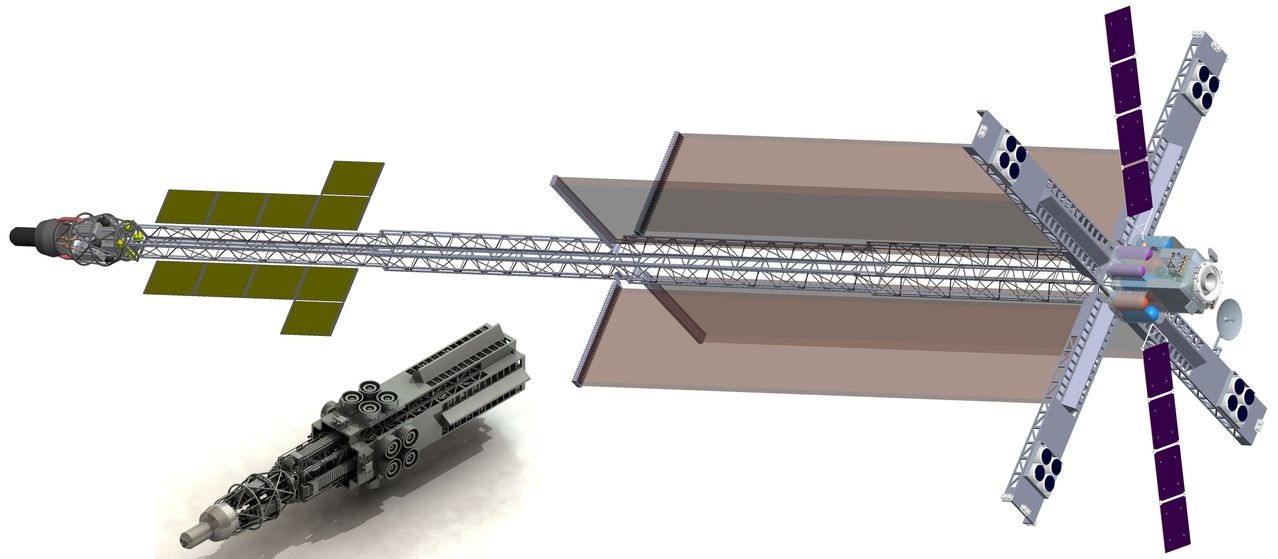
The first draft version of the TEM with 4 drip refrigerators (beige-brown panels). Bottom render in the folded position. (c) RKK Energy
To conduct R&D in 2010, a program worth 17 billion rubles was launched, of which 7.245 billion rubles were allocated to the reactor, 3.955 to the energy conversion system, and about 5.8 billion to the remaining spacecraft. The NIKIET Institute (the creator of the lead fast BREST) was commissioned to do the nuclear reactor, the energy conversion system - Information Center named after Keldysh, and the entire spacecraft - RSC Energia.
The appearance of the first edition of TEM struck any engineer who knew the context. An ultrahigh-temperature (1600K!) Fast gas-cooled reactor, uranium carbonitride fuel (promising, but little studied), turbocompressor units operating at 60,000 rpm with a temperature on the turbine of 1500K for 10 years continuously, heat exchangers, for the same 1500K. The expandable design of the apparatus is 54 meters long and 20 wide, in the initial state it fits under the PH fairing. A record megawatt space electrical system with a voltage of 4.5 kilovolts, supplying 16 ion electric propulsion systems with a power of 60 kilowatts each (10 times more powerful than those flying at that time and 1.5 times more powerful than laboratory record holders). Finally, the spacecraft itself, which was supposed to withstand 10 times the large dose of radiation,
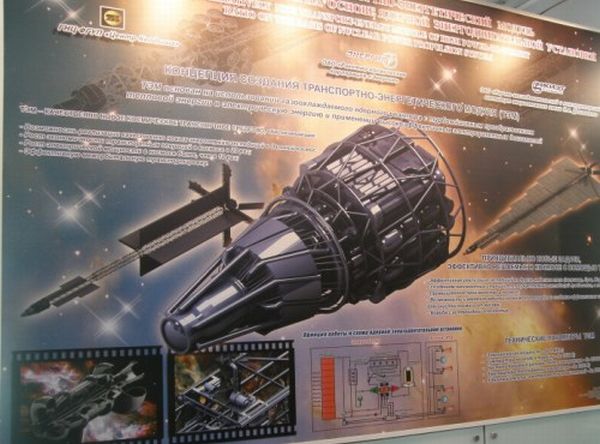
TEM poster for MAKS 2013. Two main concepts are visible behind the nuclear block on the left and on the right - with drip and panel CI
The project began to develop, regularly shining with perspectives and innovations in interviews, TV and conferences. Rosatom took on the work most briskly - quickly abandoning the carbonitride fuel in favor of the familiar oxide, a nuclear reactor was designed, a mixture of standard and new. In a cylindrical stainless steel case with a diameter of 50 cm and a length of about a meter, several hundred cylindrical fuel rods containing highly enriched uranium oxide in single-crystal molybdenum claddings with a diameter of 4-5 mm are located. The total estimated mass of fuel is 80-150 kg, depending on the achievable burnout. The control is carried out by moving and extending 19 absorbing rods of a control system of boron carbide in a molybdenum shell. The fast reactor has a thermal power of 3, 8 megawatts and is cooled by a gas mixture of 78% helium and 22% xenon at a working pressure of 40 atm. The temperature of the gas mixture at the inlet is 1200, and at the outlet 1500K (1227 C).
TEM core model for hydraulic testing. Forgive NIKIET for the poor quality of a rather unique image
The nuclear installation is being developed by several Rosatom enterprises, including The IPPE, which has been developing space nuclear power plants for many decades, NPO Luch, which owns high-temperature fuel element technologies, and the internal reactor behavior of TEM nuclear power elements in a loop with a hot working gas mixture was conducted by the NIIAR, which has the largest fleet of research reactors in the country. In spite of the departure from the NIKIET in 2012, the chief designer of the reactor V.P. Smetannikov’s development of the reactor continues almost on schedule: a loop with a new coolant and a standard fuel element was tested, a partial thermo-hydraulic test bench was created, and a ground-based nuclear power plant model is being built at NITI in Sosnovy Bor. The launch of this installation is planned for 2015, and such a launch will be the undisputed victory of nuclear engineering.
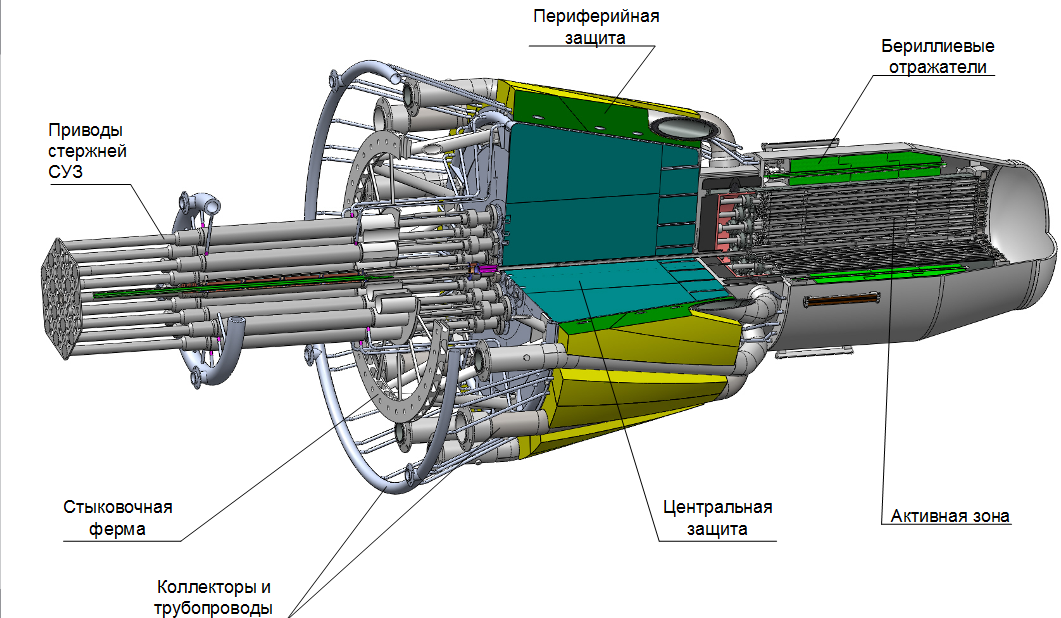
An early version of the RUGK reactor for the TEM nuclear power plant. (c) Rosatom
Another cooperation from the IC named after Keldysh, KBHM, KBHA and VNIIEM was engaged in a turbomachine converter. At TEM, it is planned to install 4 identical modules with a capacity of 250 kilowatts. The system also includes AC / DC and DC / DC converters, buffer batteries, additional equipment cooling systems. Together with the nuclear reactor, the mass of the power unit was to be 6800 kg.
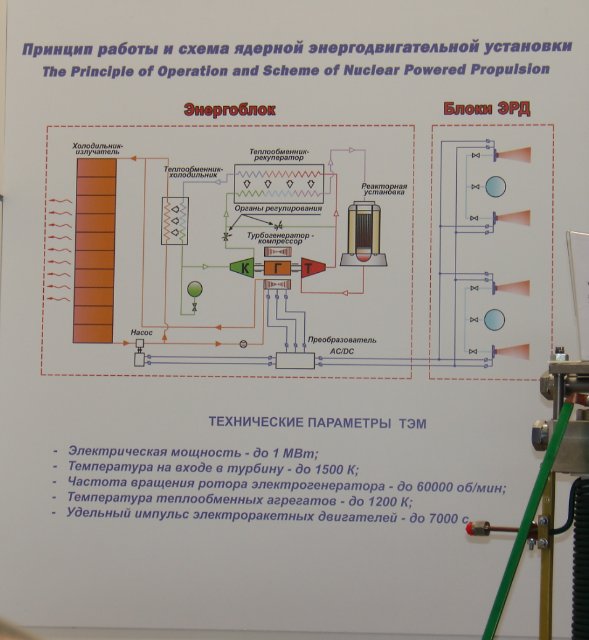
Scheme and parameters of nuclear power TEM. (c) Keldysh Center.
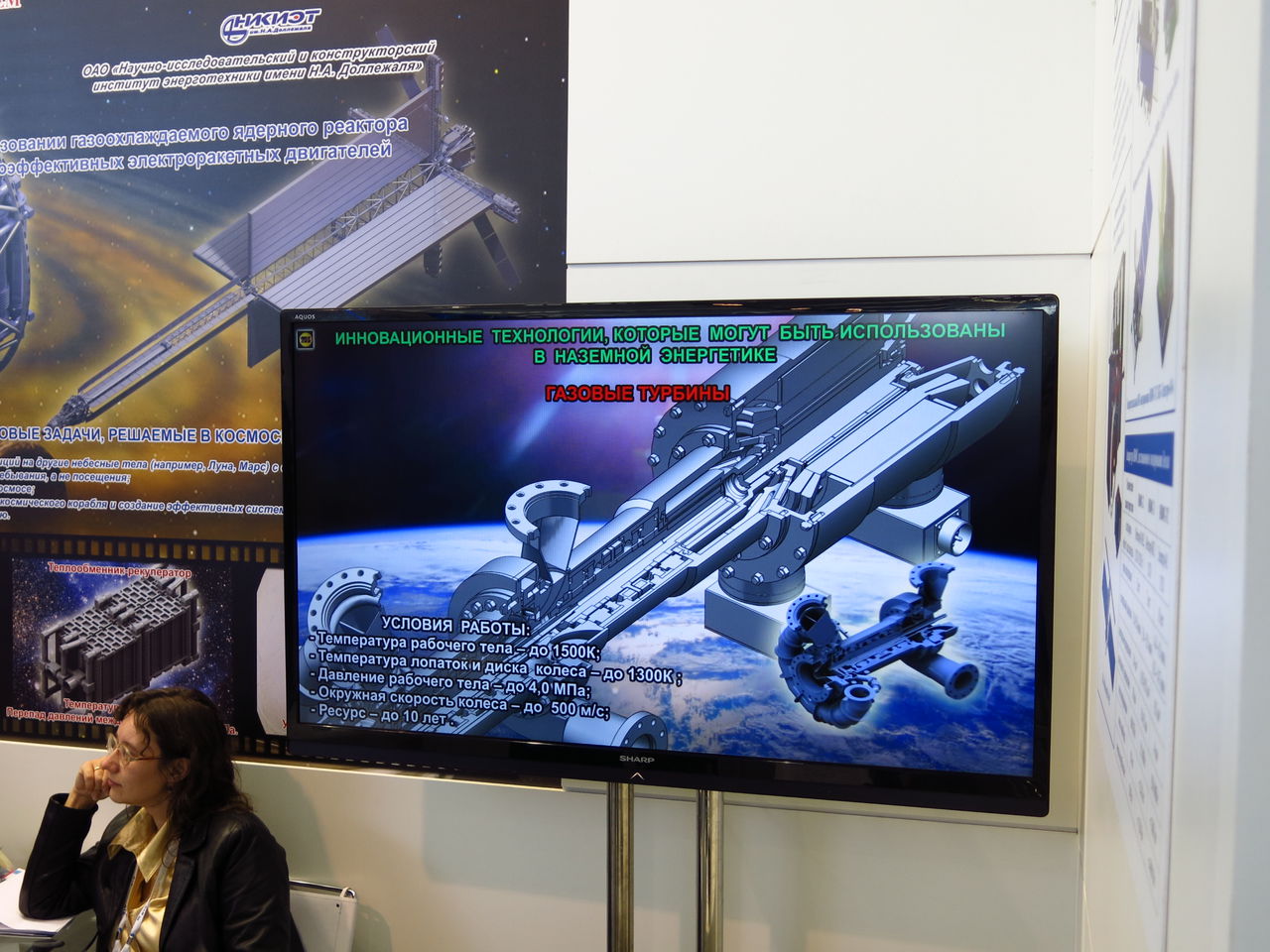
Frame from the video of the Center named after Keldysh with a cut of 250 kilowatt TEM turbogenerator. (c) A. Ilyin
Thermal energy is converted into electrical energy in the gas turbine cycle (Brighton), where the energy of the gas extracted from the turbine goes both to the electric generator and to the rotation of the compressor that maintains the gas circulation. Through the heat exchanger, the residual heat is discharged into the second circuit, where it is dissipated into space with the help of refrigerator emitters.
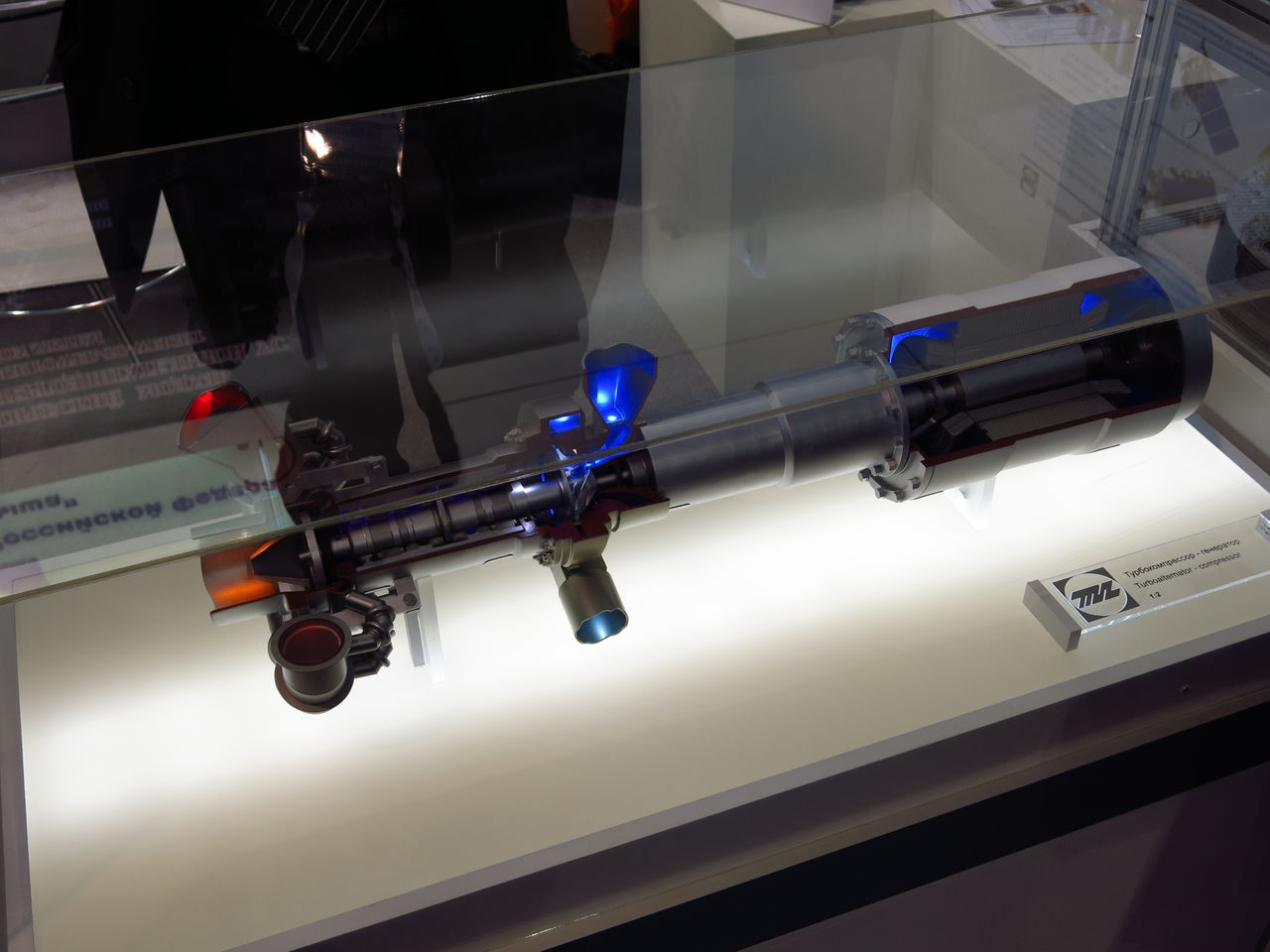
Model 250 kW TEM turbogenerator 1: 2 (s) Anik
The complexity of developing elements of a turbomachine conversion system is comparable to the complexity of a reactor. Separately, all requirements are feasible: there are gas turbines at temperatures higher than 1500K, and turbo-pumps of rocket engines pumping hydrogen have rotation speeds and peripheral speeds even higher than 60,000 and 500 m / s. However, to collect everything at once in combination with a 10-year maintenance-free resource - the jump was clearly above his head. For example, problems with high-temperature gas heat exchangers at one time cut off a very promising direction of regenerative gas turbine engines, and gas-dynamic bearings for weightlessness are quite difficult to test for a resource in gravity.
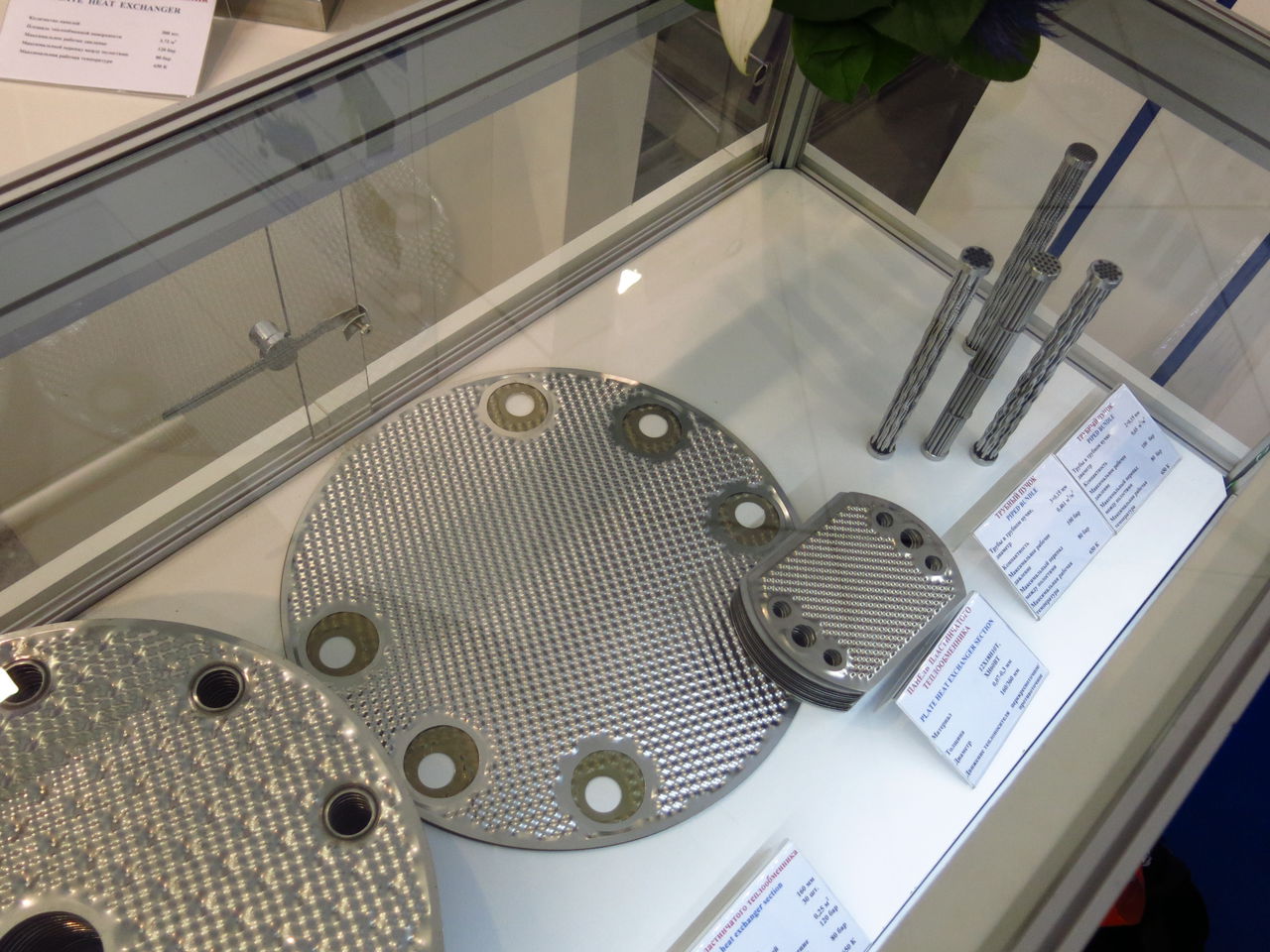
TEM heat exchanger plates. (c) A. Ilyin
In 2013, Information Center named after Keldysh reported on successes in creating prototypes of all the most important elements of a turbomachine converter - two types of heat exchangers, a generator and a gas turbine unit. However, according to the latest R&D data, they are quite tight and the equipment life is far from necessary. Already in the fall of 2013, it was postulated that drip refrigerators are far from engineering, and they cannot be developed yet. The promised record ionic ERE gradually fade - the problems with large-sized perforated electrodes with a high resource that no one in the world can solve remain unresolved.

The prototype of the TEM ion engine from the Keldysh Center. Already smaller in size compared to the original idea © A. Ilyin
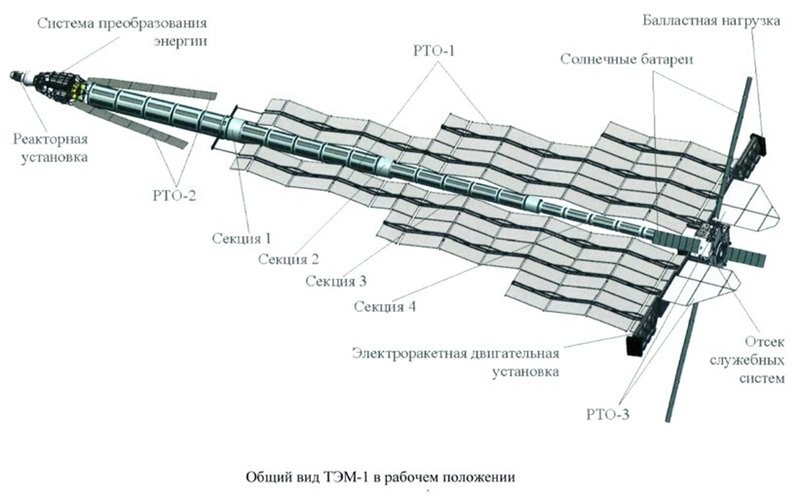
Option TEM with panel refrigerators
In addition, the interaction of the Keldysh Center (part of Roscosmos), headed by Academician Koroteev with other large space enterprises, is often tense with mutual mudsliding, which also does not contribute to progress. TEM, beautifully painted at the stage of the preliminary design, begins to crumble at the stage of confirming the characteristics of the units.

Model of a folded TEM, summer 2013. Pay attention to ion engines - there were 24 against 15 on the early model. Refrigerators are still drip
Finally, the work of enterprises led by RSC Energia was aimed at creating a spacecraft proper armed with a nuclear energy source. Energia was forced to take up the front of work, which blocked the way for its own development of a tugboat with a Hercules thermionic nuclear power plant, and the front of the problems was wider than that of the other two main “bunters”. It was necessary to create a heavy spacecraft with all the traditional elements on board - orientation and orbital maneuvering systems on hydrazine rocket engines, powerful solar panels and telemetry, landing systems for payload and refueling, xenon tanks, and finally make it all work for 10 years in radiation conditions. Even more specific elements should have become:
- folding trusses for the removal of nuclear power from the spacecraft body, with an elongation in space of 2.5 times, from 20 to 54 meters;
- the expanding coolant pipelines and their sealing - all this should work smoothly in vacuum and radiation conditions;
- HI folding panels with an area of hundreds of square meters;
- high-voltage power lines for electric propulsion;
- folding wings carrying electric propulsion and refrigerator emitters.
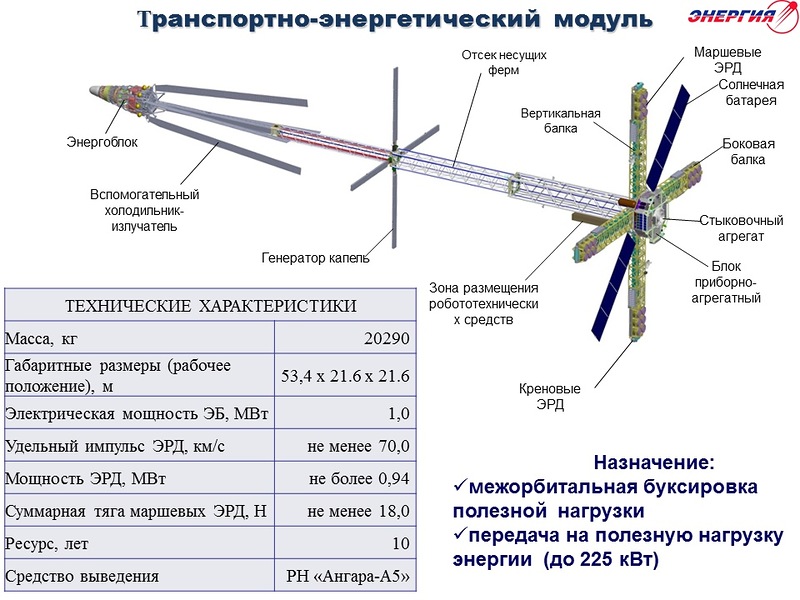
TEM preliminary design in the presentation of RKK-Energia
All this magnificence was required to be shoved into a maximum of 22 tons, which the Angara-5 launch vehicle is capable of taking. In fact, immediately after the sketch of the future TEM was issued, RSC Energia began to intensively rake the TEM from the project, having thrown off some of the tasks at GKNPTs im. Khrunicheva, and part - at the Arsenal Design Bureau - the creators of the US-A and Plasma-A spacecraft. RKK representatives begin to tell in an interview that tugs based on the SB are not so bad. Arsenal, in turn, blows dust from its tug projects from 300-500 kW of thermionic nuclear power plant.
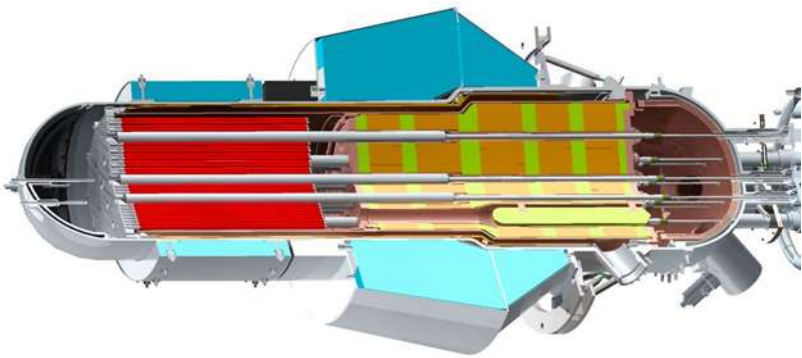
TEM reactor section in the technical design version. (c) NIKIET
At the end of 2014, the difficult situation with the project results in its sequestration within the framework of the Federal Space Program for 2016-2025. It remains funding for research, and mainly through the line where there are some results - the actual nuclear reactor and turbomachine converters. The TEM space launch is being removed from plans, and we see how the future, in which humanity has new tools for space exploration, is melting, as in the photographs in Back to the Future. Once again, as in the case of Hercules or JIMO, humanity is rolling back, unable to overcome the technical barrier to the creation of powerful space reactors.

American AMC JIMO, also planned with a nuclear reactor on board.
It is well known that weight is the main enemy of space nuclear power plants, and refrigerators for stray heat are the heaviest element of such devices. In the case of thermionic emission converters, this question is solved quite elegantly - yes, their efficiency is low compared to the turbine cycle, but the temperature of the radiators of the radiators can be very high (about 1000K, and the reactor itself is warmed up to 1650K), and as we remember, the weight of the refrigerators depends from temperature to the power of 1 / T ^ 4. As a result, this power-law dependence is replayed by a fourfold larger volume of heat, which must be discharged from a thermionic nuclear power plant. Only if you do not have the revolutionary idea of a drip CI.
The idea is that instead of driving fluid through the tubes inside the emitting panels, it will fly straight through space - from the nozzle-shapers of the jets to the drop eliminator. In this case, theoretically, the weight of CI can be reduced several times, and losses due to evaporation into vacuum are solved by the selection of a special organosilicon liquid. In this scenario, thermionic nuclear power plants begin to play their “birthmark” - a low power density on the electricity generating fuel rods, and well, the efficiency is 5-8%.
It is this concept of TEM - with turbomachine conversion of thermal energy and drip refrigerators that was proposed by the Keldysh Center Center in 2009. Innovation of the idea fell on fertile ground at the peak of “the development of innovations in the country” by President Medvedev, and multiplied by the strength of the lobbyists of Rosatom and the head of IC Keldysh Academician Koroteyev, it was possible to swap the miserable “archaic” projects of RKK Energia, KB Arsenal, OJSC Krasnaya Zvezda from the board and get the cherished financing.

The first draft version of the TEM with 4 drip refrigerators (beige-brown panels). Bottom render in the folded position. (c) RKK Energy
To conduct R&D in 2010, a program worth 17 billion rubles was launched, of which 7.245 billion rubles were allocated to the reactor, 3.955 to the energy conversion system, and about 5.8 billion to the remaining spacecraft. The NIKIET Institute (the creator of the lead fast BREST) was commissioned to do the nuclear reactor, the energy conversion system - Information Center named after Keldysh, and the entire spacecraft - RSC Energia.
The appearance of the first edition of TEM struck any engineer who knew the context. An ultrahigh-temperature (1600K!) Fast gas-cooled reactor, uranium carbonitride fuel (promising, but little studied), turbocompressor units operating at 60,000 rpm with a temperature on the turbine of 1500K for 10 years continuously, heat exchangers, for the same 1500K. The expandable design of the apparatus is 54 meters long and 20 wide, in the initial state it fits under the PH fairing. A record megawatt space electrical system with a voltage of 4.5 kilovolts, supplying 16 ion electric propulsion systems with a power of 60 kilowatts each (10 times more powerful than those flying at that time and 1.5 times more powerful than laboratory record holders). Finally, the spacecraft itself, which was supposed to withstand 10 times the large dose of radiation,

TEM poster for MAKS 2013. Two main concepts are visible behind the nuclear block on the left and on the right - with drip and panel CI
The project began to develop, regularly shining with perspectives and innovations in interviews, TV and conferences. Rosatom took on the work most briskly - quickly abandoning the carbonitride fuel in favor of the familiar oxide, a nuclear reactor was designed, a mixture of standard and new. In a cylindrical stainless steel case with a diameter of 50 cm and a length of about a meter, several hundred cylindrical fuel rods containing highly enriched uranium oxide in single-crystal molybdenum claddings with a diameter of 4-5 mm are located. The total estimated mass of fuel is 80-150 kg, depending on the achievable burnout. The control is carried out by moving and extending 19 absorbing rods of a control system of boron carbide in a molybdenum shell. The fast reactor has a thermal power of 3, 8 megawatts and is cooled by a gas mixture of 78% helium and 22% xenon at a working pressure of 40 atm. The temperature of the gas mixture at the inlet is 1200, and at the outlet 1500K (1227 C).
TEM core model for hydraulic testing. Forgive NIKIET for the poor quality of a rather unique image
The nuclear installation is being developed by several Rosatom enterprises, including The IPPE, which has been developing space nuclear power plants for many decades, NPO Luch, which owns high-temperature fuel element technologies, and the internal reactor behavior of TEM nuclear power elements in a loop with a hot working gas mixture was conducted by the NIIAR, which has the largest fleet of research reactors in the country. In spite of the departure from the NIKIET in 2012, the chief designer of the reactor V.P. Smetannikov’s development of the reactor continues almost on schedule: a loop with a new coolant and a standard fuel element was tested, a partial thermo-hydraulic test bench was created, and a ground-based nuclear power plant model is being built at NITI in Sosnovy Bor. The launch of this installation is planned for 2015, and such a launch will be the undisputed victory of nuclear engineering.

An early version of the RUGK reactor for the TEM nuclear power plant. (c) Rosatom
Another cooperation from the IC named after Keldysh, KBHM, KBHA and VNIIEM was engaged in a turbomachine converter. At TEM, it is planned to install 4 identical modules with a capacity of 250 kilowatts. The system also includes AC / DC and DC / DC converters, buffer batteries, additional equipment cooling systems. Together with the nuclear reactor, the mass of the power unit was to be 6800 kg.

Scheme and parameters of nuclear power TEM. (c) Keldysh Center.

Frame from the video of the Center named after Keldysh with a cut of 250 kilowatt TEM turbogenerator. (c) A. Ilyin
Thermal energy is converted into electrical energy in the gas turbine cycle (Brighton), where the energy of the gas extracted from the turbine goes both to the electric generator and to the rotation of the compressor that maintains the gas circulation. Through the heat exchanger, the residual heat is discharged into the second circuit, where it is dissipated into space with the help of refrigerator emitters.

Model 250 kW TEM turbogenerator 1: 2 (s) Anik
The complexity of developing elements of a turbomachine conversion system is comparable to the complexity of a reactor. Separately, all requirements are feasible: there are gas turbines at temperatures higher than 1500K, and turbo-pumps of rocket engines pumping hydrogen have rotation speeds and peripheral speeds even higher than 60,000 and 500 m / s. However, to collect everything at once in combination with a 10-year maintenance-free resource - the jump was clearly above his head. For example, problems with high-temperature gas heat exchangers at one time cut off a very promising direction of regenerative gas turbine engines, and gas-dynamic bearings for weightlessness are quite difficult to test for a resource in gravity.

TEM heat exchanger plates. (c) A. Ilyin
In 2013, Information Center named after Keldysh reported on successes in creating prototypes of all the most important elements of a turbomachine converter - two types of heat exchangers, a generator and a gas turbine unit. However, according to the latest R&D data, they are quite tight and the equipment life is far from necessary. Already in the fall of 2013, it was postulated that drip refrigerators are far from engineering, and they cannot be developed yet. The promised record ionic ERE gradually fade - the problems with large-sized perforated electrodes with a high resource that no one in the world can solve remain unresolved.

The prototype of the TEM ion engine from the Keldysh Center. Already smaller in size compared to the original idea © A. Ilyin

Option TEM with panel refrigerators
In addition, the interaction of the Keldysh Center (part of Roscosmos), headed by Academician Koroteev with other large space enterprises, is often tense with mutual mudsliding, which also does not contribute to progress. TEM, beautifully painted at the stage of the preliminary design, begins to crumble at the stage of confirming the characteristics of the units.

Model of a folded TEM, summer 2013. Pay attention to ion engines - there were 24 against 15 on the early model. Refrigerators are still drip
Finally, the work of enterprises led by RSC Energia was aimed at creating a spacecraft proper armed with a nuclear energy source. Energia was forced to take up the front of work, which blocked the way for its own development of a tugboat with a Hercules thermionic nuclear power plant, and the front of the problems was wider than that of the other two main “bunters”. It was necessary to create a heavy spacecraft with all the traditional elements on board - orientation and orbital maneuvering systems on hydrazine rocket engines, powerful solar panels and telemetry, landing systems for payload and refueling, xenon tanks, and finally make it all work for 10 years in radiation conditions. Even more specific elements should have become:
- folding trusses for the removal of nuclear power from the spacecraft body, with an elongation in space of 2.5 times, from 20 to 54 meters;
- the expanding coolant pipelines and their sealing - all this should work smoothly in vacuum and radiation conditions;
- HI folding panels with an area of hundreds of square meters;
- high-voltage power lines for electric propulsion;
- folding wings carrying electric propulsion and refrigerator emitters.

TEM preliminary design in the presentation of RKK-Energia
All this magnificence was required to be shoved into a maximum of 22 tons, which the Angara-5 launch vehicle is capable of taking. In fact, immediately after the sketch of the future TEM was issued, RSC Energia began to intensively rake the TEM from the project, having thrown off some of the tasks at GKNPTs im. Khrunicheva, and part - at the Arsenal Design Bureau - the creators of the US-A and Plasma-A spacecraft. RKK representatives begin to tell in an interview that tugs based on the SB are not so bad. Arsenal, in turn, blows dust from its tug projects from 300-500 kW of thermionic nuclear power plant.

TEM reactor section in the technical design version. (c) NIKIET
At the end of 2014, the difficult situation with the project results in its sequestration within the framework of the Federal Space Program for 2016-2025. It remains funding for research, and mainly through the line where there are some results - the actual nuclear reactor and turbomachine converters. The TEM space launch is being removed from plans, and we see how the future, in which humanity has new tools for space exploration, is melting, as in the photographs in Back to the Future. Once again, as in the case of Hercules or JIMO, humanity is rolling back, unable to overcome the technical barrier to the creation of powerful space reactors.
